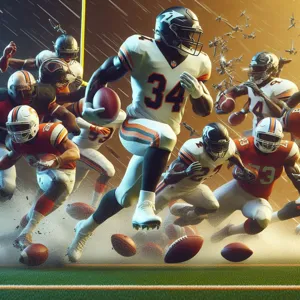In the high-octane world of American football, few sights are as exhilarating as a running back charging down the field, evading defenders with a blend of agility and speed.
Yet, equally thrilling is the art of stopping that very force, a challenge that requires skill, strategy, and precise execution. In this blog post, we delve into the most effective tackling techniques that can empower defenders to take on this formidable opponent. From understanding the running back’s movements to mastering the fundamentals of body positioning and leverage, we’ll explore a range of strategies that not only enhance individual performance but also elevate the entire defensive unit. Whether you’re a seasoned player looking to refine your skills or a coach seeking to instill sound tackling principles in your team, these techniques will provide valuable insights to help you dominate on the field and turn the tide of the game. Join us as we break down the essentials of effective tackling and equip you with the tools to stop any running back in their tracks!
1. Understanding the Role of a Running Back

To effectively tackle a running back, it’s crucial to first understand their role on the field. A running back is often considered the heartbeat of the offense, tasked with carrying the ball on rushing plays, catching passes out of the backfield, and serving as a linchpin in a team’s overall strategy. Their agility, speed, and vision allow them to navigate through defenses, making split-second decisions to evade tackles or burst through gaps.
Typically, running backs are categorized into different types, such as power backs, who rely on brute strength to bulldoze through defenders, and speed backs, who utilize their quickness and elusiveness to avoid contact altogether. Understanding these distinctions can significantly influence defensive strategies; for instance, a power back may require a more aggressive, fundamental tackling approach, while a speed back might necessitate finesse and anticipation.
Moreover, running backs are adept at reading the game, often watching for holes in the defense or the movements of their blockers. This means that they can change direction in an instant, requiring defenders to be not only physically prepared but also mentally sharp. By studying the running back’s tendencies and learning their preferred moves, such as cuts and spins, defenders can better position themselves to make the tackle.
In summary, grasping the nuances of a running back’s role is vital for any defender looking to improve their tackling techniques. It’s not just about physical prowess; it’s about strategy, anticipation, and the ability to adapt in a fast-paced game. When defenders take the time to understand the running back’s approach, they can devise more effective strategies to stop them in their tracks.
2. The Importance of Defensive Strategy
In American football, the defensive strategy is the backbone of any successful effort to stop a running back. While individual skills and athleticism are undeniably important, it is the cohesive execution of a well-thought-out defensive game plan that can truly make the difference between a victorious stand and a frustrating drive down the field.
A robust defensive strategy starts with understanding the tendencies and strengths of the opposing running back. Coaches often analyze game footage to identify how the player reacts to different defensive formations and which gaps they prefer to exploit. This knowledge informs the defensive alignment and helps players anticipate where the running back is likely to go with the ball.
Moreover, a good defensive strategy emphasizes the importance of teamwork. each player must know their role within the defensive scheme, whether it be maintaining their gap responsibilities, providing support on the edge, or fulfilling the responsibilities of a linebacker in coverage. For instance, defensive linemen are tasked with clogging running lanes, while linebackers must be prepared to react quickly to any cuts or changes in direction. This collective effort creates a wall that is harder for the running back to penetrate.
Additionally, communication is vital. Defensive players must constantly talk to one another, calling out adjustments and shifts as the offense sets up. This real-time dialogue ensures that all players are on the same page, reducing the chances of miscommunication that can lead to a significant gain for the offense.
Finally, adaptability is a key component of an effective defensive strategy. Running backs often possess the ability to change their approach mid-play, so a defense must be prepared to adjust on the fly. This could mean switching from a zone defense to a man-to-man coverage scheme or bringing an extra player into the box to counter a particularly explosive runner.
In summary, the importance of a well-structured defensive strategy cannot be overstated. It is the foundation upon which a team can build a formidable defense capable of neutralizing even the most talented running backs in the game. By understanding the opponent, fostering teamwork, maintaining communication, and being adaptable, defenses can significantly increase their chances of shutting down the running game and securing crucial victories.
3. Key Attributes of an Effective Tackler

When it comes to stopping a running back in American football, the effectiveness of a tackler cannot be overstated. A great tackle can change the momentum of a game, and understanding the key attributes of an effective tackler is essential for any player wanting to improve their defensive skills.
**1. Speed and Agility:** One of the most crucial attributes is speed. A tackle must be able to close the gap between themselves and the running back quickly. This doesn’t just mean sprinting; it also involves agility, allowing the tackler to maneuver swiftly to adjust their angle of approach. A player who can quickly change direction and accelerate will have a significant advantage in making a successful tackle.
**2. Strength and Physicality:** While speed is important, strength plays a vital role in bringing down a ball carrier. An effective tackler must possess the physicality to engage with the running back and bring them to the ground. This often requires upper body strength for wrapping up the ball carrier and lower body strength to maintain balance and leverage during the tackle.
**3. Technique and Form:** Mastery of tackling techniques is essential. This includes the ability to wrap up properly and use the body’s momentum effectively. An effective tackler should know how to lower their hips, keep their head up, and aim for the ball carrier’s midsection to ensure a clean and safe tackle. Proper form not only increases the likelihood of a successful tackle but also minimizes the risk of injury to both the tackler and the running back.
**4. Awareness and Anticipation:** A great tackler possesses keen awareness of the game. They should be able to read the running back’s movements and anticipate their next move. This foresight allows them to position themselves effectively, ready to execute the tackle at the right moment. Understanding the running back’s tendencies and the offensive scheme can provide a significant edge.
**5. Tenacity and Determination:** Finally, an effective tackler must have an unyielding attitude. Tackling requires mental toughness and a relentless approach. A running back may try to shake off a tackle or break through, but a determined tackler will continue to pursue until the play is over, embodying the spirit of the game.
By honing these attributes, a player can transform into a formidable force on the field, making them a key player in any defensive lineup. Mastering the art of tackling not only enhances personal performance but also contributes significantly to the overall success of the team.
4. Fundamental Tackling Techniques
When it comes to stopping a running back in American football, mastering fundamental tackling techniques is crucial. These foundational skills not only enhance your effectiveness on the field but also ensure the safety of both the tackler and the ball carrier. Here’s a closer look at the essential techniques that every defender should incorporate into their game.
**1. The Proper Stance:** Start with a balanced stance that allows for quick movement in any direction. Feet should be shoulder-width apart with knees slightly bent, ready to explode forward. Keeping your head up and eyes on the runner will help you assess the situation and react swiftly.
**2. Approach and Angle:** As you close in on the running back, it’s important to take an appropriate angle. Aim to cut off their path by anticipating their movements. A well-timed angle can significantly reduce the distance you need to cover, making it easier to make the tackle.
**3. The Hip Drop:** When you get within range, focus on the hip drop technique. This involves lowering your body and leading with your shoulder while keeping your head up. Aim to make contact with the runner’s hips, which can throw off their balance and make it harder for them to escape.
**4. Wrap and Roll:** Once you’ve made contact, it’s time to wrap up. Use your arms to secure the runner, wrapping around their waist or legs. This ensures they can’t break free. As you wrap, leverage your body weight and momentum to roll through the tackle, bringing the runner down effectively.
**5. Follow Through:** Lastly, don’t forget the follow-through. Ensure that you’re not just stopping the runner but also driving them to the ground. A good tackle often requires persistence, so keep your legs churning and maintain your grip until the ball carrier is down.
By honing these fundamental tackling techniques, defenders can significantly improve their ability to halt even the most agile running backs. Remember, consistent practice and a focus on safety will not only bolster your skills but also contribute to a stronger, more cohesive defensive unit on the field.
5. The Role of Positioning and Angles

When it comes to tackling a running back in American football, the importance of positioning and angles cannot be overstated. A well-timed tackle is not just about brute strength; it’s about finesse and strategic placement on the field. Understanding the dynamics of angles can significantly enhance a defender’s effectiveness, turning potential misses into successful stops.
Positioning begins with anticipation. A defender must read the play, gauge the running back’s trajectory, and position themselves accordingly. The optimal spot often lies slightly ahead of the running back’s path, allowing the defender to cut off their route without overcommitting. This requires excellent awareness and a keen understanding of the running back’s tendencies. Is he more likely to juke to the left or power through defenders? Knowing this can inform a defender’s positioning, giving them the upper hand.
Once in position, the angle of approach plays a crucial role. A defender should aim to approach from an angle that minimizes the running back’s options. By closing the distance at a diagonal rather than head-on, the defender can effectively force the running back to move in a predictable manner—often towards the sideline or into the waiting arms of teammates. This strategy also helps to avoid direct confrontations that could lead to missed tackles, as a straight-on approach can sometimes leave a defender vulnerable to a quick sidestep.
Moreover, the importance of using body leverage should not be overlooked. By angling one’s body correctly, a defender can create a shield, using their hips and shoulders to direct the running back into a more favorable position for the tackle. This method not only increases the chance of a successful stop but also helps to protect the defender from being knocked back.
In summary, mastering positioning and angles is essential for any defender looking to effectively tackle a running back. By honing these skills, players can transform their defensive strategy, turning potential tackles into game-changing stops. Remember, it’s not just about the tackle itself; it’s about the art of getting there first, controlling the situation, and making the play count.
6. Using Leverage to Your Advantage
Using leverage to your advantage is a game-changing strategy when it comes to stopping a running back in American football. This technique hinges on the understanding that football is not just about brute strength; it’s also about positioning and technique. When you leverage your body correctly, you can maximize your effectiveness while minimizing the risk of injury.
As a defender, your goal is to get low. By bending your knees and lowering your center of gravity, you can achieve a more stable base, allowing you to push against the running back with more force. This low stance not only helps you stay balanced but also makes it harder for the running back to shake off your tackle.
Timing is crucial. As the running back approaches, you want to anticipate their movements and position yourself accordingly. This means reading their body language and understanding their tendencies. If you can get your body in front of them while maintaining a low center of gravity, you create a wall they must navigate around, giving you the leverage to disrupt their momentum.
Additionally, utilizing your arms effectively is vital. Extend your arms to engage the running back, creating a barrier that they must either go over or around. This technique not only slows them down but also allows you to bring them down more easily when the moment is right.
Remember, leverage is not just about how you use your body but also about how you position yourself on the field. Engage your teammates to create a swarm effect, where multiple defenders converge on the running back from different angles. The collective leverage can be overwhelming, making it much more difficult for the running back to break free.
In summary, by mastering the art of leverage—positioning your body, timing your movements, and working in tandem with your teammates—you can effectively neutralize a running back’s impact on the game, making it a key strategy in your defensive arsenal.
7. The Impact of Speed and Agility

In the fast-paced world of American football, speed and agility are not just desirable traits; they are essential weapons in the defensive arsenal. When it comes to stopping a running back, understanding the impact of these attributes can mean the difference between a successful tackle and a frustrating miss.
Speed allows defenders to close the gap between themselves and the ball carrier quickly, enabling them to respond to plays as they unfold. A running back who can accelerate rapidly poses a significant challenge, as they can exploit any hesitation or misstep from a defender. This is where the agility of a player comes into play. Agility isn’t merely about speed; it involves the ability to change direction swiftly and efficiently. A defender who possesses excellent agility can navigate through blockers and adjust their path to meet the running back head-on, cutting off potential escape routes.
To effectively counter a speedy and agile running back, defenders must also train their own agility and reaction time. Drills that focus on lateral movement, quick footwork, and explosive starts are crucial in preparing for encounters with elusive ball carriers. Furthermore, understanding the running back’s tendencies—such as their preferred moves and cutting patterns—can give defenders a strategic edge. By anticipating the running back’s next move, defenders can position themselves more favorably, making it easier to deliver a decisive tackle.
Ultimately, the combination of speed and agility creates a dynamic challenge for defenders. Those who can master these elements not only enhance their individual performance but contribute significantly to their team’s ability to contain one of the most dangerous positions on the field. As the game continues to evolve, the emphasis on speed and agility will remain a cornerstone of defensive strategies aimed at stopping running backs in their tracks.
8. The Importance of Teamwork in Stopping a Running Back
In the high-octane world of American football, stopping a running back is rarely a solo endeavor; it’s a symphony of teamwork that makes the difference between a successful tackle and an embarrassing miss. While individual skills and athleticism are crucial, the essence of halting a dynamic running back lies in the seamless collaboration of the entire defensive unit.
When the ball is snapped and the running back darts into the open field, each player has a vital role to play. The defensive linemen must engage with their blockers, creating a wall that limits the running back’s options. Meanwhile, linebackers need to read the play quickly, anticipating where the ball carrier is headed. Their ability to communicate effectively, calling out formations and adjustments, can turn a chaotic moment into a calculated response.
Secondary players, such as safeties and cornerbacks, must remain vigilant, ready to support the front seven. They should be prepared to fill gaps and cut off any potential escape routes. This requires not only individual discipline but also a keen understanding of their teammates’ movements and responsibilities. The best defenses operate like a well-oiled machine, where each player instinctively knows when to shed a block, when to pursue, and when to support.
Furthermore, the importance of maintaining a cohesive strategy cannot be overstated. By studying the opponent’s tendencies and play-calling, teams can devise game plans that exploit weaknesses and bolster their chances of stopping the running back. Whether it’s through blitzing, zone coverage, or man-to-man assignments, a united front can disrupt the rhythm of even the most skilled ball carriers.
Ultimately, to stop a running back effectively, teams must embrace the spirit of cooperation. It’s not just about individual prowess; it’s about fostering a culture of trust and communication. When each player understands their role and works together toward a common goal, they can create a formidable defense that can stifle even the most elusive running backs. In football, as in life, the power of teamwork can lead to extraordinary results.
9. Identifying Common Running Back Moves
To effectively tackle a running back, understanding their common moves is crucial. Each running back has their own unique style, but several techniques are widely used across the board, and recognizing them can give defenders a significant advantage.
One of the most prevalent moves is the **cutback**, where a running back shifts their momentum one way before quickly changing direction to exploit gaps in the defense. This requires a defender to anticipate the move and maintain balance, as a well-timed cut can leave a defender grasping at air.
Another common maneuver is the **stiff arm**, where the running back extends their arm to ward off an approaching tackler. This move can be particularly effective, as it creates separation and allows the runner to maintain speed. Defenders must be prepared to engage quickly and decisively, aiming to wrap up rather than just make contact.
**Spin moves** are also frequent, allowing a running back to evade tackles by rotating their body mid-run. This technique requires quick footwork and agility, and defenders need to be aware of their positioning to avoid being spun around and left out of the play.
Additionally, many running backs employ the **jump cut**, a sudden leap to one side that can catch defenders off guard. This lateral movement can create just enough space for a running back to burst through the line. Defenders should focus on staying low and balanced to counter this agility.
By familiarizing themselves with these common moves, defenders can better anticipate the runner’s intentions, allowing them to position themselves more effectively and ultimately improve their tackling success. Recognizing patterns and tendencies in a running back’s style can be the difference between a solid tackle and a missed opportunity on the field.
10. Drills to Improve Tackling Skills
In the high-octane world of American football, mastering tackling techniques is essential for any player looking to effectively stop a running back in their tracks. While theoretical knowledge is vital, the real magic happens on the practice field. To elevate your tackling skills, incorporating specific drills into your training regimen is crucial. Here are a few drills that can make a significant difference in your performance:
**1. Pursuit Drills:** These drills focus on the fundamental skills of pursuit and angle of attack. Set up a cone or marker where the running back will start. As the running back takes off, defensive players must practice taking the optimal angle to cut off the runner while maintaining speed. This drill emphasizes the importance of positioning and understanding the runner’s trajectory, helping defenders anticipate moves.
**2. Tackle Bag Drills:** Using a tackle bag is an excellent way to practice the physicality of tackling without the risk of injury. Players can work on their form by hitting the bag with proper technique—keeping their heads up, using their shoulders, and wrapping up. This drill helps reinforce muscle memory and build confidence in making tackles.
**3. One-on-One Tackling:** This drill pairs up a defender with a running back in a controlled setting. The objective is simple: the running back tries to evade the defender, while the defender works on breaking down their movements and executing the tackle. This drill mimics game scenarios, allowing players to practice timing, angles, and the mental aspect of tackling under pressure.
**4. Open Field Tackling:** In this drill, coaches set up a large area where a running back can operate freely. Defenders must practice tackling in open space, focusing on footwork and body positioning to ensure they can bring down the runner effectively. This is critical because open-field tackles often determine the outcome of plays, and players need to be prepared for one-on-one situations.
**5. Wrap and Roll Drill:** This technique-oriented drill emphasizes the importance of wrapping up the ball carrier. Players practice tackling by wrapping their arms around a partner or a tackling dummy, rolling their bodies to bring the runner down. This drill reinforces the correct technique, reducing the risk of injury to both the tackler and the tackled.
By integrating these drills into regular practice, players can refine their tackling techniques, develop confidence, and ultimately become more effective in stopping the opposing running backs. Consistent repetition and focus on form are key, as tackling is as much about technique as it is about physicality. So, lace up those cleats and hit the practice field—your skills will speak for themselves come game day!
11. Mental Preparation: Anticipating the Runner’s Moves
Mental preparation is a crucial yet often overlooked aspect of stopping a running back in American football. While physical skills and techniques are essential, the ability to anticipate a runner’s moves can set apart an average defender from an elite one. Understanding the psychological game behind the run can significantly enhance your defensive strategy.
First, immerse yourself in film study. Analyze footage of your opponent’s previous games to identify patterns in their running style. Notice how they react to different defensive formations and what choices they make when faced with pressure. Are they patient, waiting for a hole to develop, or do they rely on explosive speed to break through? Recognizing these tendencies allows you to predict their actions on the field and position yourself accordingly.
Next, develop your situational awareness. A successful defender must not only focus on the runner but also keep an eye on the offensive line’s movements and the overall flow of the play. Is the offensive line shifting, signaling a possible play direction? Are the receivers making blocks downfield? By reading the play as it unfolds, you can anticipate the runner’s path and prepare to make your move.
Additionally, mental visualization techniques can be incredibly beneficial. Spend time imagining various scenarios where you face off against the running back. Visualize their speed, agility, and the potential paths they might take. This mental rehearsal can enhance your reaction time and decision-making during the game, allowing you to respond instinctively when the moment arises.
Lastly, cultivate a resilient mindset. Running backs are often trained to exploit any hesitation or doubt in a defender. By maintaining confidence in your abilities and committing fully to your anticipated moves, you can effectively disrupt the runner’s strategy. When you combine keen observation, situational awareness, mental visualization, and a strong mindset, you equip yourself with the tools necessary to outsmart and outplay even the most elusive running backs on the field.
12. Safety First: Tackling Techniques to Avoid Injuries
In the high-octane world of American football, the thrill of the game is often accompanied by the risk of injury, particularly when it comes to tackling. To ensure the safety of both the tackler and the ball carrier, mastering proper tackling techniques is paramount. The old adage “safety first” truly rings true on the field, and understanding how to execute tackles safely can significantly reduce the likelihood of injuries.
One of the foundational principles of safe tackling is to always keep your head up. This means that players should avoid leading with their helmet, which not only puts them at risk for concussions but also increases the chance of serious injuries to both parties involved. Instead, players should focus on leading with their shoulder while keeping their eyes on the ball carrier. By maintaining a clear line of sight, players can gauge the movement and positioning of the runner, allowing for better decision-making in the tackle.
Another essential technique is the “wrap and roll” approach. When making contact, players should aim to wrap their arms around the opponent’s waist or legs, effectively securing the tackle while minimizing the impact. By using their body weight to roll their opponent to the ground, tacklers can ensure a safer landing for both themselves and the runner. This technique not only helps in preventing injuries but also provides a more effective means of bringing down even the most elusive of running backs.
Moreover, players should be mindful of their body positioning. Tacklers should approach the ball carrier at an angle rather than head-on, which can create a more controlled and safer environment during the tackle. This angle allows for better leverage and minimizes the risk of catastrophic collisions that can lead to injuries.
Coaching drills that emphasize these safe tackling techniques can help reinforce these skills during practice. Incorporating agility drills, form tackling exercises, and controlled scrimmages allows players to practice their technique in a safe environment, preparing them for the real-game scenarios while instilling habits that prioritize safety.
By prioritizing safety in tackling techniques, players can enjoy the thrill of the game while minimizing the risk of injury. Remember, a well-executed tackle not only stops the running back in their tracks but also ensures that everyone leaves the field in one piece, ready to play another day.
13. Learning from the Pros: Case Studies of Successful Tackles
When it comes to mastering the art of tackling, there’s no better teacher than experience—and who better to learn from than the pros? Analyzing the techniques of elite players can provide invaluable insights into effective tackling strategies that can be adapted to your own game.
Consider the legendary Ray Lewis, known for his bone-crushing tackles and unmatched field awareness. Lewis mastered the art of timing and positioning, often waiting for the perfect moment to strike, using his low center of gravity to explode through the runner. His technique involved not only physical prowess but also an exceptional understanding of the game, allowing him to anticipate the running back’s movements. Watching film of his tackles reveals a blend of speed, precision, and intensity that can inspire any player looking to improve their skills.
Another standout example is the aggressive tackling style of Bobby Wagner. Wagner’s approach emphasizes leverage and angles; he often positions himself to cut off the running back’s path before contact. His ability to read plays quickly, combined with his relentless pursuit, showcases a technique rooted in preparation and anticipation. By studying his game tape, players can learn how to effectively use their body position to gain an advantage over their opponents.
Finally, let’s not overlook the finesse of players like Tyrann Mathieu, who demonstrate that tackling is not just about brute strength. Mathieu has a knack for wrapping up opponents effectively while minimizing the risk of penalties. His techniques showcase the importance of using proper form and technique to ensure safe and effective tackles.
By examining these case studies, aspiring players can glean valuable lessons on tackling that extend beyond physical ability. Incorporating the best practices from these professionals into your training regimen can elevate your tackling game, making you a formidable force on the field. Remember, every great tackler was once a student of the game—so take notes from the pros and continuously refine your technique.
14. Adapting Strategies for Different Game Situations
In the fast-paced world of American football, the ability to adapt your tackling strategies to different game situations is crucial for effectively stopping a running back. Each game scenario presents unique challenges that require players to think on their feet and adjust their techniques accordingly.
For instance, if your team is ahead in the score and the running back is known for their explosive speed, it may be wise to employ a more conservative approach and focus on maintaining gap integrity rather than risking an aggressive tackle that could leave a hole in your defense. This might mean positioning yourself to funnel the running back towards your teammates, allowing for a collective effort to bring them down.
Conversely, in a critical fourth-quarter situation where your team needs a stop, you might opt for a more aggressive tackling technique, such as a high-impact wrap tackle, to immediately halt the running back’s momentum. In these high-stakes moments, timing and decisiveness are key. Understanding not only your opponent’s tendencies but also the game clock and score can dictate whether you should go for the big hit or prioritize safety and positioning.
Moreover, conditions on the field—like wet grass or muddy turf—can also play a significant role in your tackling strategy. On slick surfaces, players may struggle to maintain their footing, making it more effective to aim for lower tackles that bring the running back down with minimal risk of slipping.
Ultimately, mastering the art of adaptation means being observant and flexible. Every play is an opportunity to assess the running back’s style and your own team’s dynamics. By honing your ability to adjust your tackling strategies in real-time, you not only enhance your own performance but also contribute to a cohesive defensive effort that can effectively stymie even the most formidable rushing attacks.
15. Conclusion: Continuous Improvement in Tackling Techniques
As the game of American football evolves, so too must the strategies employed by players and coaches alike, particularly when it comes to tackling techniques. The conclusion drawn from our exploration of effective strategies to stop a running back is clear: continuous improvement is not just an option; it is a necessity.
Football is a dynamic sport where the tactics that worked yesterday may not be effective tomorrow. As running backs develop new skills, become faster, and adopt more elusive running styles, defenders must adapt accordingly. This requires a commitment to ongoing education and practice. Coaches should prioritize regular training sessions that focus on refining tackling techniques as well as incorporating new drills that simulate the unpredictability of game situations.
Moreover, players must be encouraged to analyze their own performances critically, learning from both successes and failures. Utilizing video footage can provide valuable insights into tackling form, positioning, and timing, allowing players to make data-driven adjustments to their technique.
In addition to physical training, fostering a mindset of resilience and adaptability is crucial. The best tacklers are not only skilled athletes but also strategic thinkers who can anticipate the moves of their opponents. By embracing a culture of continuous improvement, teams can cultivate a defensive unit that is not just reactive but proactive, consistently staying one step ahead of the competition.
Ultimately, the journey toward mastering tackling techniques is ongoing. By committing to continuous improvement, players and teams can enhance their performance on the field, reduce the risk of injury, and increase their chances of stopping even the most formidable running backs. Remember, in football, as in life, excellence is not a destination but a relentless pursuit.
In conclusion, successfully stopping a running back in American football requires a blend of strategy, technique, and teamwork. By implementing the techniques outlined in this article—such as proper tackling form, understanding the opponent’s running style, and maintaining disciplined gap integrity—you can significantly enhance your defensive performance on the field. Remember, every game is an opportunity to learn and adapt, so continually refining your skills and strategies will pay off as you face diverse opponents. With dedication and practice, you’ll not only improve your own game but also contribute to your team’s overall success. Now, get out there, put these strategies into action, and become the formidable force on the field that every running back fears!






